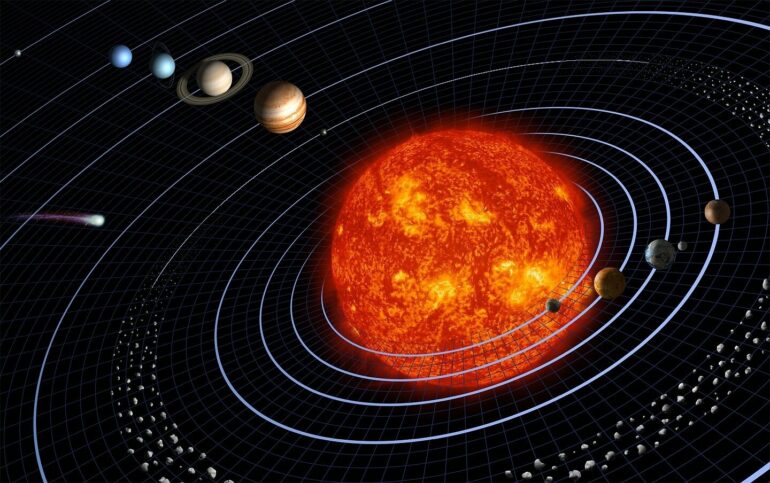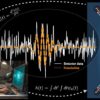Emily Simpson has loved space since she was a 10-year-old kid celebrating her birthday at a planetarium. Now a recent Florida Tech graduate, she leaves with not only a dual degree in planetary science and astronomy and astrophysics but with published research, too. She mapped our solar system’s “alternate fate” had it housed an extra planet between Mars and Jupiter instead of the existing asteroid belt.
Simpson’s paper, “How might a planet between Mars and Jupiter influence the inner solar system? Effects on orbital motion, obliquity, and eccentricity,” was published in Icarus, a journal devoted to the publication of research around solar system studies. It was co-authored by her advisor, assistant professor of planetary science Howard Chen.
They developed a 3D model that simulates how the solar system’s orbital architecture may have evolved differently with the formation of a planet that is at least twice the size of Earth’s mass—a super-Earth—instead of an asteroid belt.
“What if the asteroid belt, instead of forming the ring of smaller asteroids that it is today, what if it had instead formed a planet between Mars and Jupiter instead,” Simpson asked. “How would that affect the inner planets, so Venus, Earth, and Mars, specifically?”
According to Chen, since the discovery of the first exoplanet in 1992, researchers have wondered how common solar systems—a group of planets orbiting a star—are, as well as how many of those planet systems are like our solar system. He said our solar system is rare; most planetary systems are more compact than ours, and many systems contain super-Earth planets.
Understanding how the habitability of our solar system’s inner planets—Mercury, Venus, Earth and Mars—would change had there been a super-Earth opposite Mars can help guide astrobiologists’ research on which planetary systems may be able to support life, the researchers said.
In her study, Simpson proposed five different potential planet masses ranging from 1% of the Earth’s mass to 10 Earth masses. With each mass, she modeled 2 million years of orbit to find what kind of architectural impact each mass would have on our solar system. Specifically, she tracked changes to the other planets’ obliquities—how much a planet tilts on its axis—and eccentricities—how much a planet’s orbit deviates from a true circle.
Obliquity influences the intensity of temperature in each season: greater tilt creates more intense temperatures, while less tilt creates milder temperatures. Eccentricity determines the length of each season: lower eccentricity evens out the four seasons into similar lengths, while higher eccentricity creates an imbalance of the number of days in each season.
Simpson and Chen found that the lower-massed simulations made less of an impact on the inner planets’ habitability. They found some changes in obliquity—Mars “wobbled” a bit more, Simpson said—but overall, the inner solar system remained habitable.
“If it’s one or two Earth masses, which is still a pretty big planet, our inner solar system would still remain quite nice. We might experience slightly hotter summers or colder winters because there’s this sway in obliquity, but we could still live our lives,” Chen explained.
Discover the latest in science, tech, and space with over 100,000 subscribers who rely on Phys.org for daily insights.
Sign up for our free newsletter and get updates on breakthroughs,
innovations, and research that matter—daily or weekly.
With higher massed planets, however, there were more detrimental changes to the system’s structure. When simulating a planet 10 times the size of Earth’s mass, Simpson found that the inner planets experienced high obliquity and high eccentricity, leading to dangerous temperature differences between seasons. The mass may have even pushed Earth’s orbit closer to Venus and beyond the habitable zone it exists in currently.
While hypothetical, these observations can help astrobiologists predict how and where life may have a shot of surviving in a planetary system. This research also provides an idea of how big a super-Earth can get before stifling the possibility of life around it.
“If we discover a solar system-like system, but with a slightly different history—where instead of the natural belt, there is a planet—could that planet system’s inner regions still be hospitable? The answer is it depends on how big the planet is,” Simpson said. “If it’s too massive, that would probably spell doom for the planets within its orbit.”
More information:
Emily Simpson et al, How might a planet between Mars and Jupiter influence the inner solar system? Effects on orbital motion, obliquity, and eccentricity, Icarus (2024). DOI: 10.1016/j.icarus.2024.116364
Provided by
Florida Institute of Technology
Citation:
Exploring an alternate solar system: Research maps impact of ‘super-Earth’ (2025, January 13)



